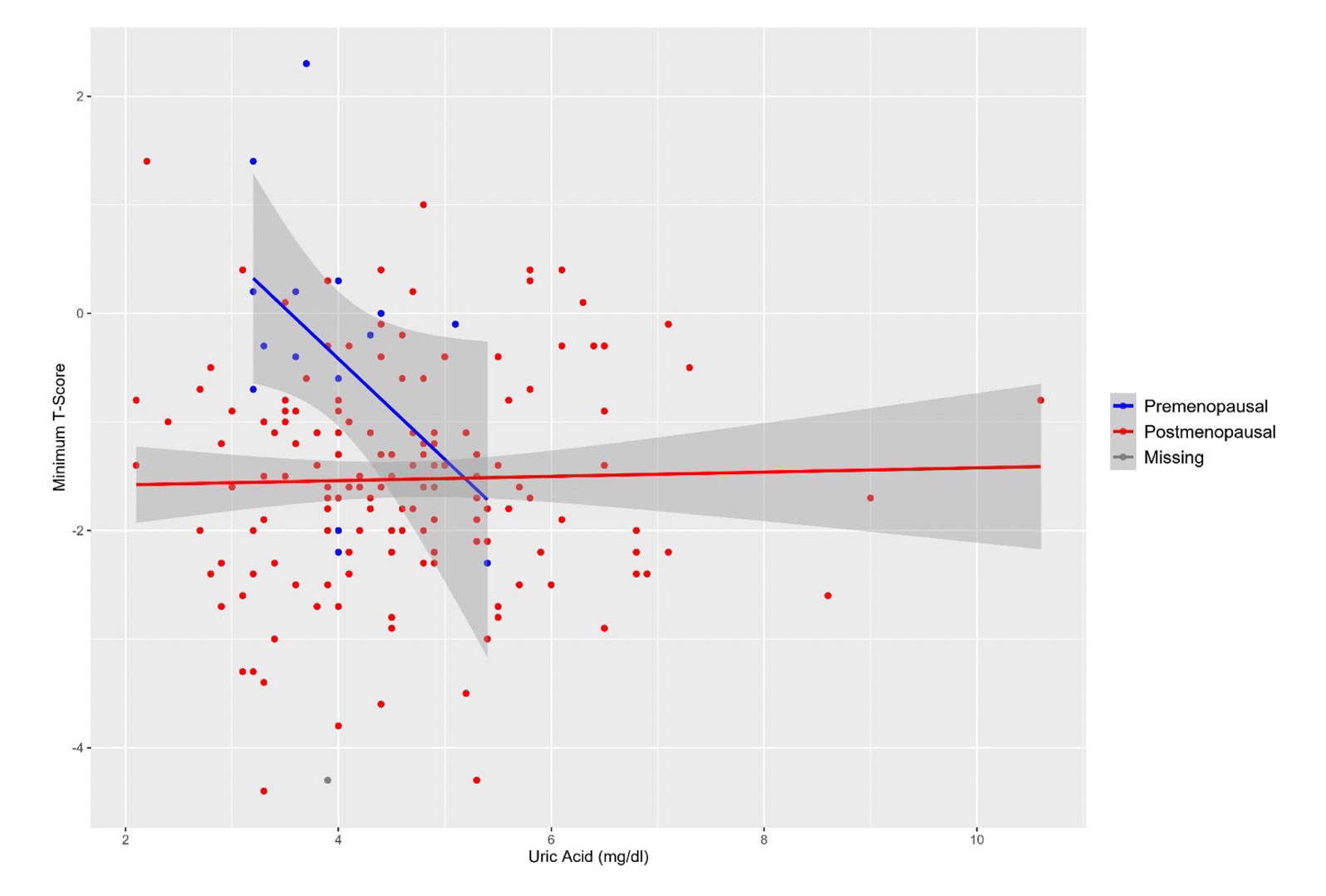Session Information
Date: Monday, November 14, 2022
Title: Metabolic and Crystal Arthropathies – Basic and Clinical Science Poster
Session Type: Poster Session D
Session Time: 1:00PM-3:00PM
Background/Purpose: Uric acid is controversially discussed regarding its effect on bone health. Higher uric acid levels have been associated with higher T-scores and fewer bone fractures in postmenopausal women. Rheumatoid arthritis (RA), as a chronic inflammatory disease, is a risk factor for fractures in both men and women. The role of uric acid in patients with RA is not yet clarified. Further, there may be different effects of uric acid on organ tissues such as the lungs, depending on the hormone status of women. We aimed at investigating the effect of uric acid level on bone mineral density and the development of osteoporosis in patients with RA and whether there is a difference between premenopausal and postmenopausal women with RA.
Methods: We utilized data from the Rh-GIOP (Glucocorticoid-Induced Osteoporosis in Patients with chronic inflammatory Rheumatic diseases) cohort, a prospective, monocentric observational study conducted at our department. All female patients with a diagnosis of RA were included in the analysis. For assessing the association between uric acid levels and lowest (minimum) T-scores measured at the lumbar spine, hip or femur, we used linear regression with adjustment for various confounders. An interaction term was included to evaluate differential associations in pre- and postmenopausal women.
Results: A total of 206 patients with RA, available dual X-ray absorptiometry (DXA) measurements, and serum uric acid levels were included in the analysis. Of those, 167 were women, and 165 had their menopausal status documented: 16 were premenopausal (age 40.32±7.85) and 149 postmenopausal (age 64.49±9.69), respectively. Postmenopausal patients had lower T-scores than non-menopausal patients. In the analysis of the whole sample, uric acid was not associated with T-scores (slope -0.08; p=0.43), but after inclusion of the interaction term, we found that uric acid was strongly negatively associated with T-scores in premenopausal women (slope -1.02; p=0.008, figure 1).
Conclusion: Uric acid appears to be negatively associated with bone mineral density in premenopausal but not in postmenopausal women with RA. This might be due to the different effect on the bone depending on the hormone status of women. Of note, the sample size of premenopausal women with RA was small. Therefore, these findings have to be proven in a larger cohort.
To cite this abstract in AMA style:
Hermann S, Palmowski A, Muche B, Hermann K, Wiebe E, Buttgereit F. Association of High Uric Acid Levels with Low Bone Mineral Density in Pre- but Not Post-menopausal Women with Rheumatoid Arthritis [abstract]. Arthritis Rheumatol. 2022; 74 (suppl 9). https://acrabstracts.org/abstract/association-of-high-uric-acid-levels-with-low-bone-mineral-density-in-pre-but-not-post-menopausal-women-with-rheumatoid-arthritis/. Accessed .« Back to ACR Convergence 2022
ACR Meeting Abstracts - https://acrabstracts.org/abstract/association-of-high-uric-acid-levels-with-low-bone-mineral-density-in-pre-but-not-post-menopausal-women-with-rheumatoid-arthritis/

